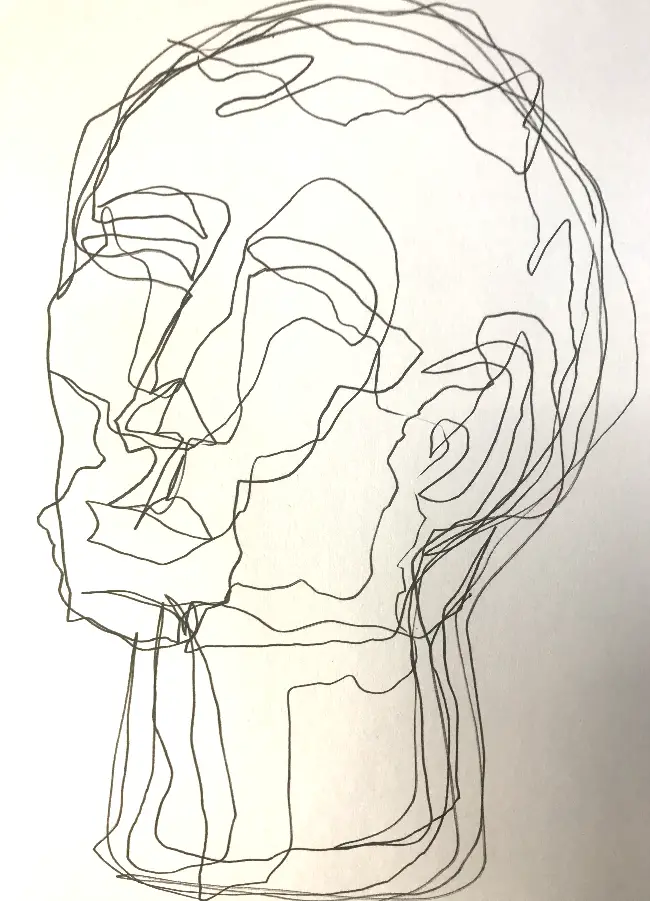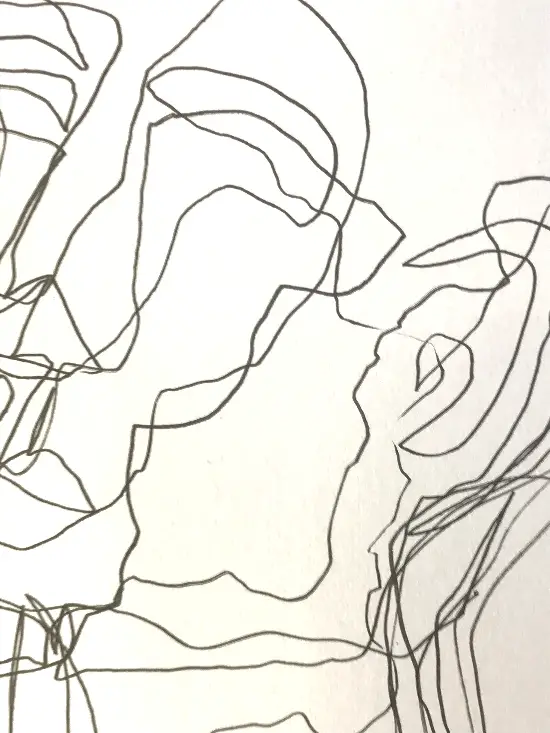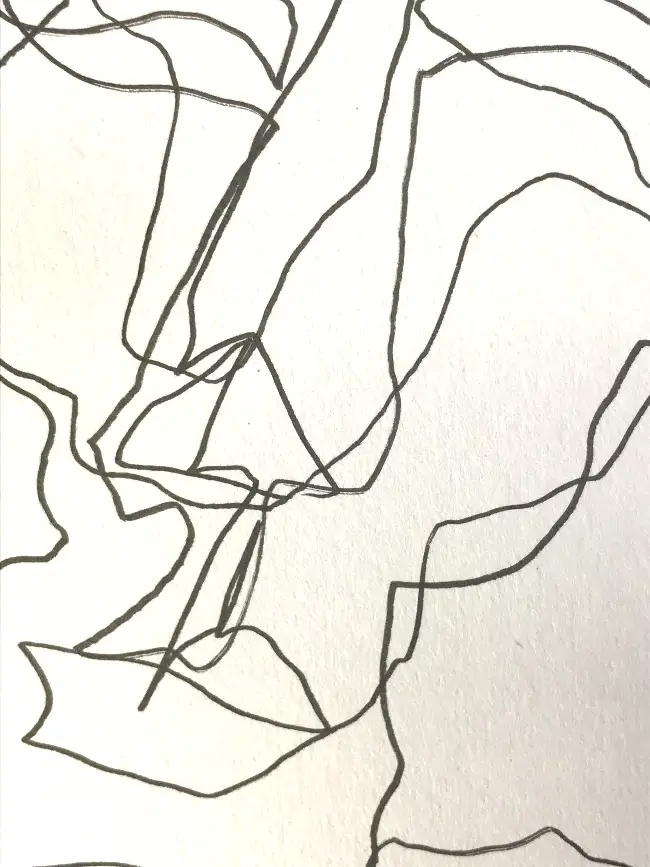Continuous Line Drawing
The first mark we made on paper when we first picked up a pencil or pen is a line. Whether guided by someone, through trial and error, or self-taught, it is from lines that we learned to make other drawings, trace contour, divide a frame, and create various tonal variations. As a matter of fact, lines are among the seven components of art, including texture, color, shape, value, form, and space.
Often done in black and white, making line drawings involves using any one color on a solid background. Also referred to as line art, line drawings is the making of illustrations by applying basic strokes of different angles and weight to show depth and form. This type of art primarily focuses on the lines instead of gradient and shading.
In other words, it is creating an individual line from one end to the other to show plane variation. A plane refers to an edge where two sides of an object come together. There are different types of lines, including two-dimensional, three-dimensional, implied, descriptive, or abstract. Lines drawings can also constitute curved lines, straight lines, narrow or thick lines, and thick and deliberate or light and sketchy. As a result, you can use line drawings to portray even the most complex subjects with ease.
Several line drawings techniques are responsible for multiple unique and valuable art pieces, worthy of immense recognition. This article will look at simple continuous line drawings, their origin, and several related drawing ideas.
Related Posts:
- What is the Difference Between Blind Contour and Contour Line Drawing?
- How to Draw Without Looking at the Paper
- How Do You Draw a Blind Contour Drawing?
- Line Drawing Techniques
WHAT IS A SIMPLE LINE DRAWING?
Also known as one-line drawing, single-line drawing refers to drawings made from a single line. Many artists use this technique to unravel the complexity of the world around us. It is possible to depict the true and natural essence and any image's complexity with just a single line. Whether it is full-body illustrations, animals, erotics, or portraits, single-line drawings are customizable to suit the artist's vision. They do not follow any professional elements. Their primary focus is to motivate the artist to capture their imagination and view objects in their way.
As a result, there are several masterpieces made from simple line drawings in the world of art. Despite being irresistible to look at, they often embody a hidden symbolism that is difficult to decipher. Take note that there are many types of line drawings, depending on the artist. They include:
* Line drawings with or without color
* Line drawings with sharp corners
* Digital vs. analog one-line drawings
* Rough vs. smooth one-line drawings
WHAT IS A SIMPLE CONTINUOUS LINE DRAWING?
Another popular technique of line drawing is the simple continuous line drawing. As implied by its name, it involves creating one line without lifting the drawing instrument from the paper to form an image. Although many artists use this form of art as a drawing exercise, simple continuous line drawings can solely stand as finished works of art.
In this form of art, the artist moves the drawing instrument back and forth across the paper without ever lifting it from the surface. In addition to internal shapes and outline, the artist will use the single unbroken line, with some lines doubling back on each other, to develop the illustration.
Upon completing the drawing, it is advisable to finalize it with an ink pen to avoid the temptation to erase any lines. While tracing back over the existing lines, ensure that you vary the line weight to showcase light and shadow areas and the different perspectives.
Often used as an exercise, simple continuous line drawings help encourage eye, hand, and brain coordination. This is because these drawings involve an in-depth focus of your subject, with minimal to no interruptions from your thinking mind. Thus, this technique further enhances the artist's observational skills and strengthens drawing skills. Furthermore, it also aids in boosting confidence and speed while drawing.
ORIGIN OF LINE DRAWINGS
Line art is everywhere. Many professional artists define line art as a moving point in space, making it one of the most crucial art elements. These simple dots in space transform into lines and then into exceptional drawings. Although they are seemingly simple to draw, line drawings are often challenging to figure out. For instance, it is possible to feel overwhelmed when trying to decipher where, when, or how to begin.
In addition to drawings and paintings, line drawings also extend their wings to photography and sculpting. For instance, photographers make an implied line using their camera angle, while sculptors use line art to combine material into multiple shapes.
The importance of line drawings in art is further evident throughout history. Many reputable and outstanding artists have used this form of art to create classic art. For example, Laocoon and his sons, an ancient sculpture group in Rome's Vatican museums, are a sensational art piece. This art has greatly influenced many artists to use implied lines to develop well-balanced illustrations in painting, drawing, and sculpture.
Another example of line art's ancient use is Leonardo Da Vinci's masterpiece, Leda and the Swan. In this work of art, several detailed line drawings develop to create dimension and form. Likewise, The Dance, from renowned artist Henri Matisse, heavily focuses on the contours present. There are also striking outlines and a bold flat color that brings out this beautiful piece of art's striking appearance, leaving a lasting impression on observers' minds.
PABLO PICASSO'S LINE ART
Pablo Picasso is, arguably, the most prolific artist of all time. Some of his most famous and ingenious works of art consist of simple line drawings, which are pretty insightful and powerful among today's artists. From mythology to still life to human form to animals, his masterpieces were all represented in truly minimalist ways using line art.
Guernica, one of the most famous paintings from Picasso, is an example of excellent use of line art to depict a complex world scenario. Named after a Northern Spanish town bombed on 26th April 1937, this painting is one of the most thought-provoking anti-war works of art in history.
Mainly focusing on the Bull and the Horse, Guernica consists of a single unbroken line that reduces these animals' complexity and fully displays their prowess. Picasso depicted life's various aspects through this stunning piece, including joy, sorrow, dark, and light. Although the art may look simple, many newbies are likely to find it complex to implement when trying it as a drawing exercise.
WHAT ARE SOME SIMPLE CONTINUOUS LINE DRAWING IDEAS?
Simple continuous line drawing requires the artist to observe the paper as they draw without any interruptions from the thinking mind. Although imperfections are undeniable, this technique can bring about surprising results as these imperfections are more likely to make the art more interesting. All in all, the end goal of a simple continuous line drawing is to achieve an end design without breaking the line's continuity.
There are numerous simple continuous line drawing ideas that one can implement to perfect their drawing skills. Some of these ideas include buildings, animals, drawing flowers, and various human forms.
HOW TO DRAW A CONTINUOUS LINE DRAWING FLOWER
Essentially, drawing a continuous line flower is relatively easy. After all, it only requires one line to develop the image. As the artist, you are responsible for the vision that you create. With a simple continuous line drawing, you have to point the paper to start and keep adding details as the pen moves continuously without lifting it off the paper until it is complete.
When making simple continuous line drawings, it is best to easily use a pen to easily shade any dark areas. Likewise, it is preferable to use an A5 paper since any paper more minor than this may make it quite difficult to add any minute details.
Before starting your continuous line drawing flower, you must envision the object by closing your eyes. Draw the image in your mind. Feel its edges, boundaries, and surfaces thoroughly. Open your eyes and take time to examine how it starts, how it goes, and where it will end. Visualize its shape, determine whether it will have sharp edges and corners, as well as your preferred form and color.
It is essential to note that you will only lift your drawing instrument in simple continuous line drawings after completing it. If you lift your pen before completing the drawing, either because of fatigue or your hand slips, start again from where you left off.
The next step is outlining your image. After finding your point's initial focus, use your pen gently without pressing its nip, hardly on the paper's surface, to outline. You may make a mistake while outlining, but these are easy to fix after shading. After outlining the image's focus, outline the rest of the flower with one continuous line.
If you get to a point where you feel the detail is over and find it challenging to begin the next step, follow the previous line until you reach the illustration's next point. This helps in making sure that everything fits within the drawing. You can also make mistakes during this process, so it is best to make the outlines as smooth and light as possible.
Finally comes shading! After drawing your outline, apply pressure to your pen to highlight the softer and richer shades in your drawing flower. Ensure that you shade all the dark areas of your drawing to shine to the focal object and elevate it to an element of focus. You can also strengthen the outline to provide additional flair to the drawing.
FINAL THOUGHTS
Lines are the underlying and fundamental principles behind visual art. No contemporary piece of art is complete without lines. Thus, if you are looking to develop your drawing skills, it is advisable to start using different line-drawing techniques, like a simple continuous line drawing. So grab your pen and sketchbook and begin practicing. Not only will you find these exercises fun, but they also improve your observational skills.




